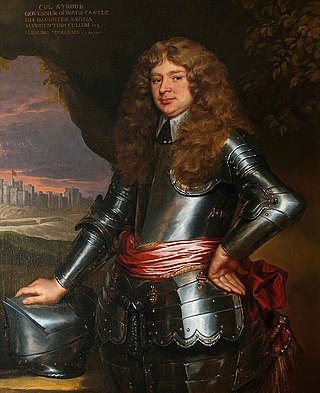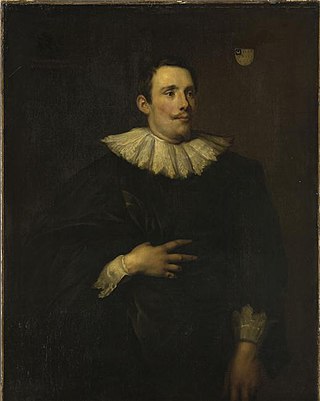
Earl of Egmont was a title in the Peerage of Ireland, created in 1733 for John Perceval, 1st Viscount Perceval. It became extinct with the death of the twelfth earl in 2011.

Viscount Gage, of Castle Island in the County of Kerry of the Kingdom of Ireland, is a title in the Peerage of Ireland. It was created in 1720 for Thomas Gage, along with the subsidiary title of Baron Gage, of Castlebar in the County of Mayo, also in the Peerage of Ireland. In 1744 he also succeeded his cousin as eighth Baronet, of Firle Place. The titles remain united. The Gage family descends from John Gage, who was created a baronet, of Firle Place in the County of Sussex, in the Baronetage of England on 26 March 1622. His great-grandson, the seventh Baronet, represented Seaford in Parliament. He was succeeded by his first cousin, Thomas Gage, 1st Viscount Gage, the eighth Baronet. He sat as a Member of Parliament for Minehead and Tewkesbury and also served as Governor of Barbados. In 1720, 24 years before succeeding in the baronetcy, he was raised to the Peerage of Ireland as Baron Gage and Viscount Gage. His second son was the military commander the Hon. Thomas Gage.
Baron Ravensworth, of Ravensworth Castle in the County Palatine of Durham and of Eslington Park in the County of Northumberland, is a title in the Peerage of the United Kingdom.

There have been three baronetcies created for members of the Ingilby/Ingleby family, one in the Baronetage of England, one in the Baronetage of Great Britain and one in the Baronetage of the United Kingdom. The latter title is extant while the other two creations are extinct.

The Glynne Baronetcy, of Bicester in the County of Oxford, was a title in the Baronetage of England. It was created on 20 May 1661 for William Glynne, the former Member of Parliament for Carnarvon. He was the son of Sir John Glynne, Lord Chief Justice during the Commonwealth. The second Baronet sat as Member of Parliament for Oxford University and Woodstock. The sixth Baronet was Member of Parliament for Flintshire and Flint. The title became extinct on the death in 1874 of Sir Stephen Glynne, 9th Baronet. The family estates, including Hawarden Castle in Flintshire, had been rescued from bankruptcy by the wealth of Sir John Gladstone, whose son William Ewart Gladstone had married the ninth Baronet's sister Catherine; on his death, they passed to Catherine and William's eldest son William Henry Gladstone.
There have been three baronetcies created for persons with the surname Dryden, one in the Baronetage of England and two in the Baronetage of Great Britain. Two of the creations are extant and are joined under a single holder since 1874.

There have been three baronetcies created for persons with the surname Carew, two in the Baronetage of England prior to 1707, one in the Baronetage of Great Britain.
Anne Hoby was an English heiress.

Sir Stephen Lennard, 2nd Baronet of Wickham Court, West Wickham, Kent was an English landowner and Whig politician who sat in the House of Commons of England in two periods between 1681 and 1701 and in the House of Commons of Great Britain from 1708 to 1709.

Sir William Oglander, 1st Baronet was an English politician who sat in the House of Commons of England from 1660 to 1670. He supported the Royalist side in the English Civil War.
John Doddington was an English landowner and politician who sat in the House of Commons in 1640.

Nunwell House, also Nunwell Manor, is a historic English country house in Brading, Isle of Wight. Located 3 miles (4.8 km) south of Ryde, the Tudor and Jacobean style house also has later additions. The house contains family militaria. It was occupied by the Oglander family from Norman times. Nunwell House is a Grade II* listed building.
Oglander is a surname, and may refer to:

Sir John Oglander was an English politician who sat in the House of Commons from 1625 to 1629. He is now remembered as a diarist.

Sir John Strode of Parnham, Dorset supported the Royalist cause in the English Civil War. He held various official offices during the Protectorate and was knighted by Oliver Cromwell. After the Restoration he was a member of the Cavalier Parliament. He was knighted by King Charles II in 1662.
Hardingshute Manor is a manor house in the parish of Brading on the Isle of Wight.
Sandown Manor is a manor house in the parish of Brading on the Isle of Wight.

Sir Henry Oglander, 7th Baronet (1811–1874) was the son of Sir William Oglander, 6th Baronet and Maria Anne Fitzroy. He inherited the baronetcy on the death of his father in 1852.
Thomas Hoby JP DL of Bisham Abbey, Berkshire and Breamore, Hampshire, was an English politician.

Sir John Strode, of the Middle Temple, London and Chantmarle, Cattistock, Dorset, was an English MP for Bridport in 1621 and 1625.














